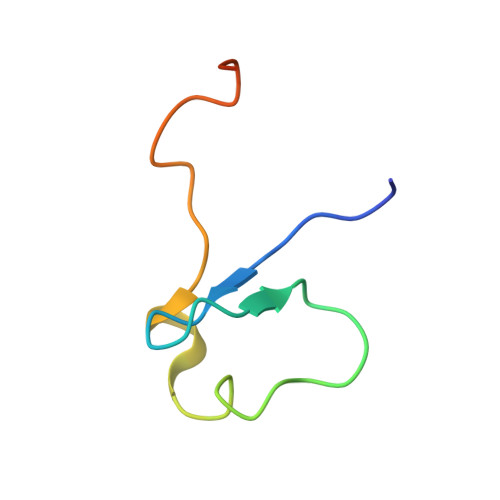Structural basis for recognition of AT-rich DNA by unrelated xenogeneic silencing proteins
Gordon, B.R.G., Li, Y., Cote, A., Weirauch, M.T., Ding, P., Hughes, T.R., Navarre, W.W., Xia, B., Liu, J.(2011) Proc Natl Acad Sci U S A 108: 10690-10695
- PubMed: 21673140
- DOI: https://doi.org/10.1073/pnas.1102544108
- Primary Citation of Related Structures:
2L92, 2L93 - PubMed Abstract:
H-NS and Lsr2 are nucleoid-associated proteins from Gram-negative bacteria and Mycobacteria, respectively, that play an important role in the silencing of horizontally acquired foreign DNA that is more AT-rich than the resident genome. Despite the fact that Lsr2 and H-NS proteins are dissimilar in sequence and structure, they serve apparently similar functions and can functionally complement one another. The mechanism by which these xenogeneic silencers selectively target AT-rich DNA has been enigmatic. We performed high-resolution protein binding microarray analysis to simultaneously assess the binding preference of H-NS and Lsr2 for all possible 8-base sequences. Concurrently, we performed a detailed structure-function relationship analysis of their C-terminal DNA binding domains by NMR. Unexpectedly, we found that H-NS and Lsr2 use a common DNA binding mechanism where a short loop containing a "Q/RGR" motif selectively interacts with the DNA minor groove, where the highest affinity is for AT-rich sequences that lack A-tracts. Mutations of the Q/RGR motif abolished DNA binding activity. Netropsin, a DNA minor groove-binding molecule effectively outcompeted H-NS and Lsr2 for binding to AT-rich sequences. These results provide a unified molecular mechanism to explain findings related to xenogeneic silencing proteins, including their lack of apparent sequence specificity but preference for AT-rich sequences. Our findings also suggest that structural information contained within the DNA minor groove is deciphered by xenogeneic silencing proteins to distinguish genetic material that is self from nonself.
- Department of Molecular Genetics, University of Toronto, Toronto, ON, Canada M5S 1A8.
Organizational Affiliation:
















